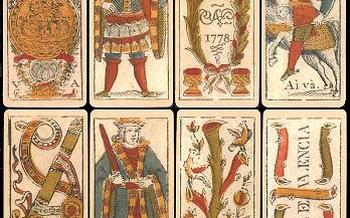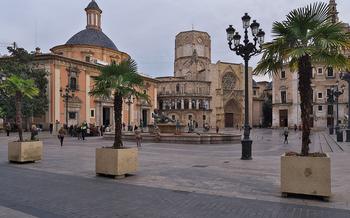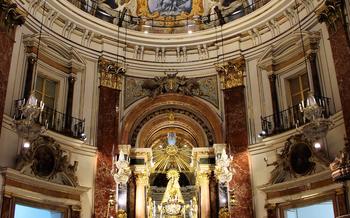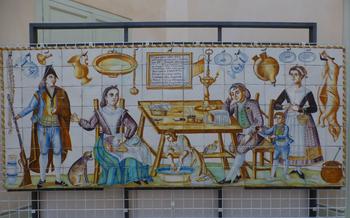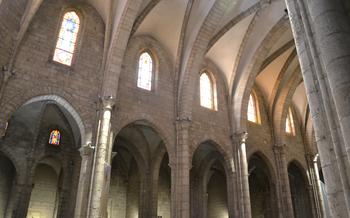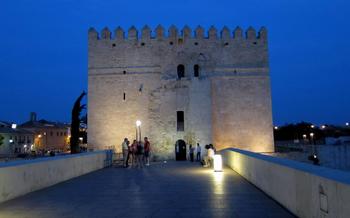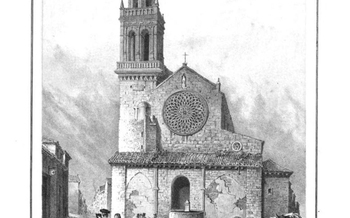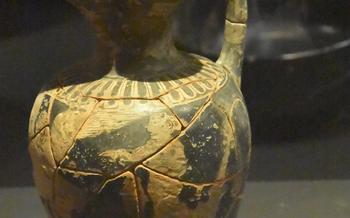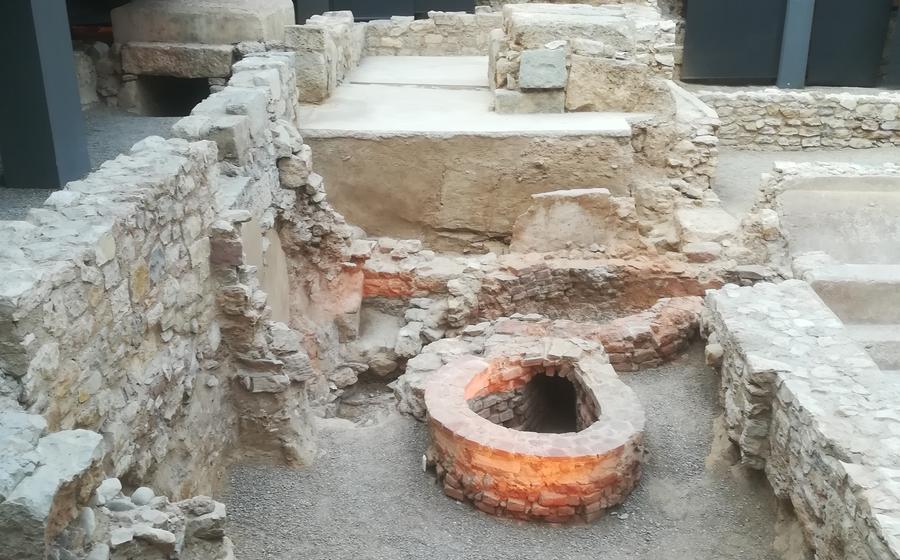
La Almoina Archaeological Center
- Historical Significance
- Location and Access
- Opening Hours and Admission
- The Archaeological Site
- The Roman Forum
- The Baths of the Almoina
- The Visigothic Church
- The Arab House
- The Christian Reconquest
- The Renaissance Palace
- The Archaeological Museum
- Educational Programs and Workshops
- Accessibility and Facilities
- Events and Exhibitions
- Insider Tip
Historical Significance
The La Almoina Archaeological Center offers an extraordinary journey through various historical periods that have shaped Valencia. Its Roman roots are evident in the remains of a 1st-century BC forum, adorned with temples, markets, and administrative buildings. Iberian and Visigoth influences left their mark, with the Visigothic church showcasing an early Christian basilica. During the Islamic period, the site housed an impressive Arab house with intricate architectural details. Finally, Christian heritage is represented by a Renaissance palace and a Christian cemetery, reflecting the city's transition to a new era.
Location and Access
The La Almoina Archaeological Center is strategically situated in the heart of Valencia's historic center, within the Ciutat Vella district. Its proximity to the iconic Valencia Cathedral makes it an ideal destination for those seeking a comprehensive cultural immersion. The center is easily accessible by public transportation, with several metro and bus lines stopping nearby. For those arriving by car, there are multiple parking options within walking distance. Whether you choose to stroll through the charming streets or take advantage of the convenient transportation links, the La Almoina Archaeological Center is effortlessly accessible, inviting you to delve into the rich history that lies beneath the surface of this vibrant city.
Opening Hours and Admission
The La Almoina Archaeological Center is open to the public from Tuesday to Sunday, with guided tours available in English and Spanish. Guided tours provide a more in-depth exploration of the site and its history, allowing visitors to gain a deeper understanding of the various periods of Valencia's past.
Admission fees are reasonable, with discounts available for students, seniors, and families. Tickets can be purchased online in advance or at the ticket office on-site. Online booking is recommended, especially during peak tourist season, to avoid queues and guarantee entry.
The Archaeological Site
Extensive excavations in the La Almoina area have uncovered a wealth of ancient remains, providing valuable insights into the history and evolution of Valencia. The site is divided into several sectors, each representing a different historical period.
The most prominent feature is the Roman Forum, the central plaza of the Roman city. Here, you can see the remains of temples, markets, and administrative buildings, along with intricate mosaic floors and artifacts. These ruins offer a glimpse into the daily life and activities of the Roman inhabitants.
Adjacent to the forum are the Baths of the Almoina, remarkably preserved Roman baths that once served as a place for relaxation and social interaction. The baths feature separate rooms for cold, warm, and hot baths, as well as a hypothermia and a swimming pool. Visitors can imagine the bathing rituals and social significance associated with these ancient baths.
The site also includes the remains of a Visigothic church, an early Christian basilica that dates back to the 6th century AD. The church features a well-preserved apse, columns, and mosaic fragments, showcasing the transition from Roman to Visigothic culture.
Finally, the Arab House offers a glimpse into the Islamic period of Valencia's history. This residential building features a courtyard, living quarters, and a kitchen, all adorned with intricate Islamic architectural elements. Together, these remains paint a vivid picture of the diverse cultural influences that have shaped Valencia over the centuries.
The Roman Forum
The Roman Forum, the heart of the ancient Roman city of Valentia, was a bustling hub of activity. This central plaza served as the political, economic, and social center, where citizens gathered for trade, religious ceremonies, and administrative matters. The ruins of the forum, uncovered during excavations, offer a glimpse into the grandeur and organization of Roman urban planning.
Temples, Markets, and Administrative Buildings
The forum was adorned with impressive temples dedicated to Roman deities, including Jupiter, Juno, and Minerva. These temples, with their intricate architectural details and sacred statues, served as places of worship and religious ceremonies. Surrounding the temples were bustling markets, where vendors sold a variety of goods, from fresh produce to imported luxuries. Administrative buildings, such as the curia (city council) and the basilica (law court), lined the edges of the forum, reflecting the importance of civic governance and justice.
Mosaic Floors and Artifacts
The grandeur of the Roman Forum is further enhanced by the stunning mosaic floors that adorn its public spaces. These intricate mosaics, with their vibrant colors and detailed designs, depict mythological scenes, geometric patterns, and everyday life. Scattered among the ruins are artifacts from the Roman period, including pottery shards, coins, and tools, offering tangible evidence of the daily lives of the city's inhabitants.
Reconstruction of Daily Life
Through the careful study of the archaeological remains, historians and archaeologists have been able to reconstruct aspects of daily life in the Roman Forum. Imagine merchants setting up their stalls, citizens bartering for goods, priests leading religious processions, and officials conducting legal proceedings. The Forum was a stage where the drama of Roman life unfolded, a place where the past and present intertwined.
The Baths of the Almoina
Amidst the ruins of the Roman city, the Baths of the Almoina stand out as a remarkably preserved example of Roman engineering and bathing culture. Built in the 1st century AD, these baths served as a vital social and hygienic hub for the city's inhabitants.
The complex features a traditional layout, with separate sections for men and women, each comprising changing rooms, cold, warm, and hot rooms, and a swimming pool. The frigidarium, or cold room, boasts a large, plunge pool with steps leading down into the icy water. The tepidarium, or warm room, features a series of heated benches where bathers could relax and socialize. The caldarium, or hot room, is the most impressive, with its vaulted ceiling and a large, circular pool filled with steaming hot water.
The Baths of the Almoina offer a fascinating glimpse into the bathing rituals and social customs of Roman society. Bathing was an essential part of Roman life, not just for hygiene but also for relaxation, exercise, and socializing. The baths were a place where people from all walks of life could come together to bathe, gossip, and conduct business.
The Visigothic Church
Amidst the ruins of Roman Valencia, the Visigothic Church stands as a testament to the city's transition from Roman to Visigothic rule. Built in the 6th century AD, this early Christian basilica showcases the architectural and religious changes that accompanied the Visigothic conquest.
The church's apse, once adorned with intricate mosaics, has been partially preserved, revealing the artistic influences of the period. Columns and capitals, bearing the marks of Visigothic craftsmanship, line the nave, their weathered surfaces whispering tales of a bygone era.
The Visigothic Church played a pivotal role in the community, serving as a center for religious worship and social gatherings. Its construction marked a significant shift in Valencia's religious landscape, as Christianity gradually replaced the polytheistic beliefs of the Roman era.
Excavations at the site have uncovered evidence of burials and rituals associated with the Visigothic community, providing insights into their funerary practices and beliefs. These findings shed light on the transition from Roman to Visigothic culture, highlighting the continuity and change that characterized this period in Valencia's history.
The Arab House
Among the diverse remains at the La Almoina Archaeological Center, the Arab House stands out as a testament to Valencia's rich Islamic heritage. Dating back to the 10th century, this residential building offers a glimpse into the daily life and culture of the city's Muslim inhabitants.
Excavated in the 1980s, the Arab House features a traditional courtyard surrounded by living quarters and a kitchen. Islamic architectural elements, such as horseshoe arches and intricate geometric patterns, adorn the walls and doorways, showcasing the artistic and cultural influences of the period.
The courtyard, the heart of the house, served as a versatile space for relaxation, social gatherings, and household activities. The surrounding rooms, with their distinct functions, provide insights into the domestic life of the period. From the private chambers to the communal areas, the Arab House offers a tangible connection to Valencia's Islamic past.
Moreover, the discovery of various artifacts within the house, including pottery, jewelry, and tools, further enriches our understanding of the material culture and daily routines of the city's Muslim community. These remnants of a bygone era offer valuable clues about their culinary habits, trade practices, and social customs.
Exploring the Arab House at the La Almoina Archaeological Center allows visitors to immerse themselves in the vibrant legacy of Valencia's Islamic period, shedding light on the city's diverse cultural heritage and the contributions of its Muslim inhabitants.
The Christian Reconquest
The Christian Reconquest of Valencia in 1238 marked a significant turning point in the history of the La Almoina site. King James I of Aragon led the Aragonese forces to victory over the Muslim rulers, bringing an end to centuries of Islamic rule in the city. The conquest ushered in a new era, as Valencia transitioned from an Islamic city to a Christian one.
The Reconquest had a profound impact on the La Almoina site. The once-thriving Islamic neighborhood was transformed into a Christian cemetery, as evidenced by the archaeological discovery of numerous burials and funerary rituals. These burials provide valuable insights into the lives and beliefs of the early Christian community in Valencia. The Reconquest also brought about significant changes to the urban landscape, as new Christian structures were built and the city underwent a process of Christianization.
The archaeological evidence from the La Almoina site offers a glimpse into this fascinating period of transition. It showcases the coexistence of different cultures and religions, as well as the social and cultural changes that accompanied the Christian Reconquest. Visitors can explore the remains of Christian burials, learn about the rituals and customs associated with death and mourning, and gain a deeper understanding of the complex and multifaceted history of Valencia.
The Renaissance Palace
In the 15th century, the site underwent another transformation with the construction of a Renaissance palace on top of the Roman ruins. This palace, known as the Palau de la Generalitat, served as the seat of the city's government and a symbol of Valencia's growing power and prosperity during the Renaissance period.
The palace exhibited a blend of Gothic and Renaissance architectural styles, characterized by its elegant facade adorned with intricate carvings, arched windows, and a stately tower. Its interior boasted grand halls, frescoed ceilings, and ornate tapestries, reflecting the opulence and sophistication of the Valencian elite.
During this period, the palace hosted lavish banquets, diplomatic receptions, and important political meetings, becoming a hub of social and political life in the city. It witnessed the rise and fall of powerful families, the enactment of significant laws, and the shaping of Valencia's destiny during a transformative era.
Today, the Palau de la Generalitat remains an iconic landmark and a testament to Valencia's rich cultural heritage. Visitors can admire its impressive facade, explore its historic halls, and learn about the fascinating stories that unfolded within its walls, providing a glimpse into the city's transition from medieval obscurity to Renaissance grandeur.
The Archaeological Museum
A visit to the on-site museum is a must for those interested in delving deeper into the history and artifacts unearthed at the La Almoina Archaeological Center. The museum houses a comprehensive collection of artifacts from various periods, providing a tangible connection to the rich past of Valencia.
Among the highlights of the collection are Roman sculptures, which offer a glimpse into the artistic traditions and craftsmanship of the era. Ceramic pieces and coins provide insights into everyday life and economic activities. Visitors can also admire Visigothic jewelry and metalwork, showcasing the artistry and techniques of this period. Islamic pottery and glassware further enrich the collection, demonstrating the cultural influences and trade connections of Valencia during the Islamic era.
The museum's displays are well-organized and informative, with detailed explanations and historical context provided for each artifact. Interactive exhibits and multimedia presentations further enhance the visitor experience, making the museum an engaging and educational resource for all ages. Overall, the Archaeological Museum at the La Almoina Archaeological Center is a valuable complement to the site, offering a deeper understanding of Valencia's diverse and fascinating history.
Educational Programs and Workshops
The La Almoina Archaeological Center offers a range of educational programs and workshops designed to engage visitors of all ages in the fascinating history of Valencia. School groups can embark on guided tours tailored to their curriculum, exploring the ancient ruins and learning about the diverse cultures that have shaped the city. Workshops on archaeology and history provide hands-on experiences, allowing participants to uncover the secrets of the past through interactive activities. Children can immerse themselves in the wonders of archaeology through engaging exhibitions specially designed to spark their curiosity and imagination. These educational initiatives play a vital role in promoting cultural heritage and fostering a deeper understanding of Valencia's rich past among the younger generation.
Accessibility and Facilities
The La Almoina Archaeological Center is committed to providing an inclusive and accessible experience for all visitors. Wheelchair users and visitors with limited mobility will find ramps and elevators throughout the site, ensuring easy access to all levels and exhibits. Spacious walkways and well-lit paths allow for comfortable navigation, and accessible restrooms are available for convenience.
To cater to the needs of families with young children, the center provides baby changing facilities in designated restrooms. For those seeking further information or assistance, a friendly and knowledgeable information desk is staffed with multilingual guides who are happy to answer questions and offer guidance.
To enhance the overall visitor experience, the site features a cafeteria where visitors can relax and enjoy a variety of refreshments. A souvenir shop is also available, offering a range of unique gifts, books, and replicas inspired by the center's rich history and collections.
Events and Exhibitions
The La Almoina Archaeological Center regularly hosts temporary exhibitions and cultural events that delve deeper into the history and significance of the site. These exhibitions showcase unique artifacts, historical documents, and interactive displays that provide visitors with a multidimensional understanding of Valencia's past.
From captivating concerts and lectures to hands-on workshops and educational programs, the center offers a diverse range of activities that cater to all ages and interests. These events create a vibrant and engaging atmosphere, fostering cultural exchange and dialogue among visitors and the local community.
Collaborations with local institutions, universities, and cultural organizations further enrich the center's programming, ensuring a continuous flow of fresh perspectives and innovative ideas. By participating in these events and exhibitions, visitors gain a deeper appreciation for the rich tapestry of Valencia's cultural heritage and its enduring legacy.
Insider Tip
To make the most of your visit to the La Almoina Archaeological Center, consider these insider tips:
-
Optimal Visit: Aim to visit during the off-season or on weekdays to avoid large crowds. This will allow you to explore the site at your own pace and appreciate the historical significance without distractions.
-
Guided Tours: Enhance your experience by booking a guided tour. Knowledgeable guides will provide in-depth insights into the archaeological discoveries and the site's rich history. Tours are available in multiple languages, ensuring accessibility for visitors from diverse backgrounds.
-
Combine and Conquer: Take advantage of the proximity to other attractions in the Ciutat Vella district. Combine your visit to the La Almoina Archaeological Center with a stroll through the picturesque streets, exploring the Valencia Cathedral, La Lonja de la Seda, and the Central Market. This will give you a comprehensive cultural and historical experience of Valencia's city center.
-
Local Delights: After your exploration, immerse yourself in the local culinary scene. Venture into the nearby streets and discover traditional Valencian restaurants and bars. Indulge in authentic dishes such as paella, tapas, and horchata, savoring the flavors that have shaped Valencia's gastronomic heritage.
